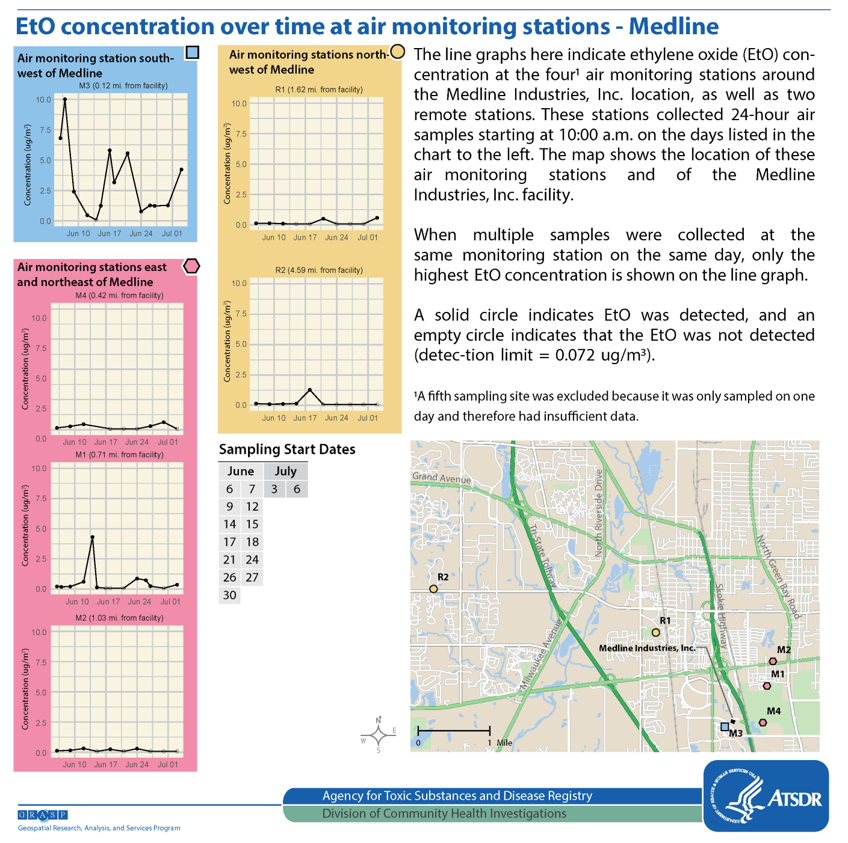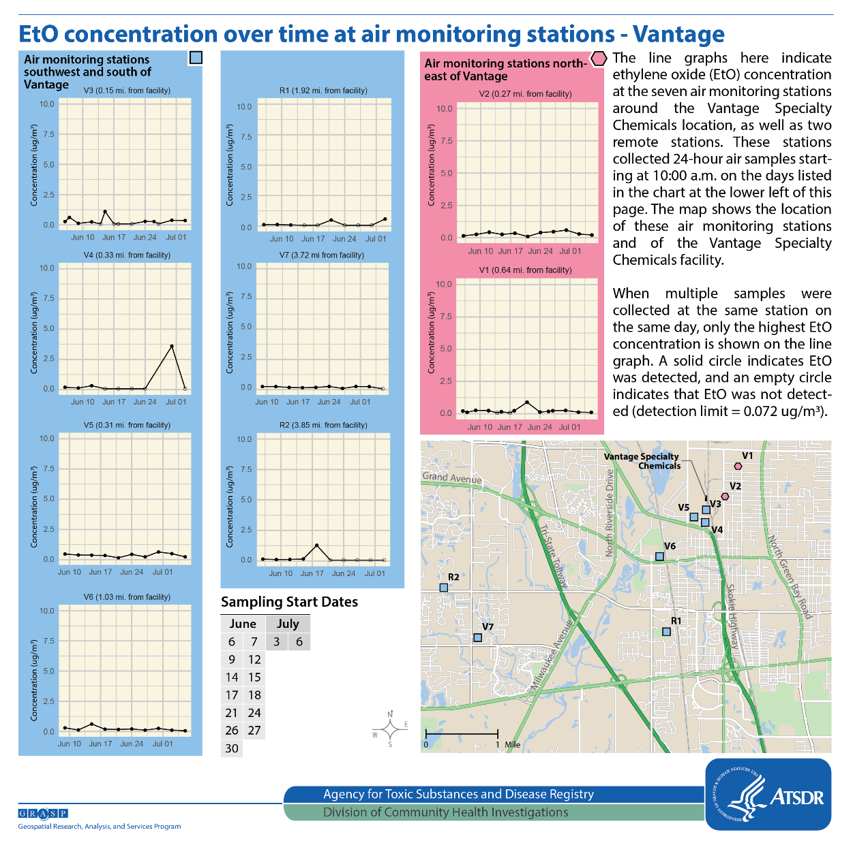Ethylene Oxide Update: November 5, 2019
Ethylene Oxide Update: November 5, 2019
The Village of Gurnee continues to work with county, state and federal officials to address concerns regarding the use of the chemical ethylene oxide (EtO), at Vantage Specialty, Inc. facility located at 3938 Porett Drive, Gurnee. Mayor Kristina Kovarik remains in regular communication with county, state and federal officials to share the concerns of the community and to receive agency and legislative updates. The following developments and communications have occurred since the last formal Village update provided on October 23, 2019:
Village of Gurnee/City of Waukegan/Lake County Health Department: A second round of outdoor air monitoring for ethylene oxide (EtO) began the week of October 21, 2019 near Vantage Specialty Chemicals in Gurnee and Medline Industries in Waukegan. In partnership with the Lake County Health Department and Illinois Environmental Protection Agency (IEPA), the Village of Gurnee and City of Waukegan have contracted GHD Services, Inc. to conduct an additional 90-day period of air monitoring to determine levels of ethylene oxide in the air. Samples will be collected every third day during the 90-day period, slated to end in January 2020. The monitoring canisters pose no health risks to residents and should not be damaged, moved, or interfered with. The canisters will be sent to a laboratory for analysis, and results will be posted publicly to the Health Department’s website, www.lakecountyil.gov/eto, as they are received.
Results will also be forwarded to the Village of Gurnee and City of Waukegan, U.S. Environmental Protection Agency (EPA), Agency for Toxic Substances and Disease Registry (ATSDR), Illinois Department of Public Health (IDPH), and IEPA which has regulatory authority over EtO emissions permitting in Illinois. The ATSDR has agreed to conduct a health risk assessment for Lake County based on the results, and IDPH has agreed to complete a cancer incidence study that includes Lake County.
Illinois Environmental Protection Agency (IEPA): On October 30, 2019 the IEPA announced that a formal public meeting to accept oral comments on a draft construction permit that will place a cap on ethylene oxide emissions from Vantage Specialties, Inc. will take place at the College of Lake County Auditorium on Thursday, November 14th from 6:30 p.m. to 9:30 p.m.
An IEPA fact sheet related to the proposed draft permit is available at:
A copy of the draft permit is available at:
The Illinois EPA Bureau of Air has drafted a permit that would set an annual cap on emissions of ethylene oxide from the plant of 110 pounds per year of which no more than 60 pounds may be fugitive emissions from components. As a point of comparison, Vantage has reported the following emission figures to EPA. The figures were calculated using an EPA-approved method that is based on actual measurements instead of the highly conservative default emission factors and assumptions.
|
Vantage Specialties, Inc. Toxic Release Inventory Facility Report: Ethylene Oxide Release Available at: https://enviro.epa.gov/facts/tri/ef-facilities/#/Release/60031MZRCH3938P |
|||||||||
|
|
2010 |
2011 |
2012 |
2013 |
2014 |
2015 |
2016 |
2017 |
2018 |
|
Fugitive Emissions |
8073 |
7984 |
2705 |
2111 |
2003 |
552 |
414 |
811 |
440 |
|
Stack Emissions |
1576 |
1725 |
720 |
721 |
720 |
725 |
713 |
736 |
622 |
|
Total Release |
9649 |
9709 |
3425 |
2832 |
2723 |
1277 |
1127 |
1547 |
1062 |
In addition, the following charts were shared by the ATSDR during the October 2, 2019 Town Hall session. Using a consistent scale, they show a comparison between the air sampling results from Medline and Vantage.


Illinois General Assembly: Two bills related to ethylene oxide were recently introduced in the House during the Veto Session. As a reminder, Vantage Specialty, Inc. is NOT a sterilizer.
- HB3885 – Introduced September 6, 2019 – Representative Durkin
HB 3885 which gives home rule communities the ability to further regulate businesses that emit EtO was debated on October 29th and did not make it out of the Energy & Environment Committee.
Summary: Amends the Environmental Protection Act. Provides that nothing within provisions regarding the control of ethylene oxide sterilization sources shall limit the ability of a home rule unit of local government to adopt an ordinance that imposes additional operating restrictions upon or prohibits ethylene oxide sterilization operations of a facility that is located within the boundaries of the home rule unit of local government and is permitted to emit ethylene oxide.
- HB3888 – Introduced September 13, 2019 – Representative Mayfield
HB3888 has been amended two times since being introduced. As currently drafted it creates a variety of definitions and regulations related to sterilizers and manufacturers that use EtO. The amended legislation made it out of Energy & Environment Committee on October 29th. It needed 16 aye votes to move to the House floor. The vote was 16 aye, 5 nay, 2 present, 8 not voting. It was on the House floor on October 30th. By a vote of 60 aye, 47 nay and 4 present it passed the House and will now be considered in the Senate when the Senate is back in session. Upcoming session dates are November 12th, 13th and 14th.
Summary: House Committee Amendment No. 1
Replaces everything after the enacting clause with the provisions of the introduced bill with the following changes: Defines and refers to the term "densely populated location" rather than "densely populated region". Provides that the terms "ethylene oxide emissions source" and "ethylene oxide sterilization source" are limited to stationary sources. Provides that on and after January 1, 2021, no ethylene oxide sterilization source in a remote location shall emit more than 30 pounds of ethylene oxide or 30 pounds of propylene oxide annually. Removes language allowing units of local government to create more restrictive standards for ethylene oxide storage. Provides that, prior to issuing specified permits, the Environmental Protection Agency shall require submission of documentation demonstrating that the permit applicant is in compliance with laws governing the storage of ethylene oxide. Requires all permits issued by the Agency to grant the Agency the authority to modify them to change storage limitations, modify storage practices or equipment requirements, and grant the Agency the right to conduct unannounced inspections. Requires the Agency to conduct at least one unannounced inspection annually of the ethylene oxide storage system for each permit holder. Provides that owners or operators of ethylene oxide sterilization sources or ethylene oxide emissions sources shall provide the Agency with specified materials within 10 (currently, 3) business days after receiving the Agency's conditional acceptance or denials of their plans. Removes provisions regarding the emission of more than 30 pounds of ethylene oxide or propylene oxide by an ethylene oxide emissions source meeting specified location requirements. Removes provisions that only permit the storage of ethylene oxide in excess of 100 pounds if it is underground. Provides that on and after January 1, 2023 (currently, January 1, 2025) critical access hospitals shall not conduct ethylene oxide sterilization operations in a densely populated location. Requires entities conducting ethylene oxide sterilization operations to submit a letter (currently, a plan) to the Agency. Removes provisions regarding a hospital's requirements concerning the plan. Provides that, on and after January 1, 2021, no ethylene oxide emissions source in a remote location shall conduct operations or other activities that emit ethylene oxide in excess of 30 pounds annually and 3 pounds monthly (currently, only 30 pounds annually). Prohibits ethylene oxide emissions sources from conducting operations or other activities that emit ethylene oxide in excess of 150 pounds annually. Requires the submission or re-submission of a risk management plan to the Agency by specified dates. Removes language requiring the Agency to conduct its comprehensive review within 180 days of the amendatory Act's effective and instead requires the Agency to submit and make publicly available its report on or before June 30, 2021. Provides that on and after January 1, 2022, the maximum cumulative emissions in a densely populated location from any sum of ethylene oxide emissions sources, hospitals, and ethylene oxide sterilization sources located within 3 and one half miles of each other shall not exceed 35 pounds annually, inclusive of any emissions not emanating from any stack. Provides that if multiple applicants request to emit ethylene oxide in a collective sum that is greater than the annual collective maximum regional emissions, the Agency shall prioritize applicants seeking to provide medical services. Makes other changes. Effective immediately.
Summary: House Floor Amendment No. 2
Replaces everything after the enacting clause with the provisions of House Amendment No. 1 and removes language making the bill effective immediately.
The process for how a bill becomes a law in Illinois can be viewed here: http://www.ilga.gov/commission/lis/98bill_law.pdf
You can find additional information on ethylene oxide and follow all updates from the Village of Gurnee on the topic here: www.gurnee.il.us/EtO
Leave a comment